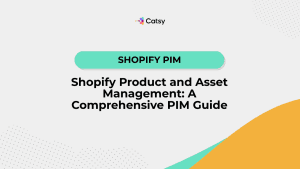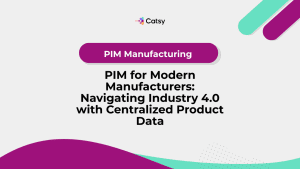Migrating from Excel to PIM Software: Step-by-Step Guide
Master migrating Excel to PIM with our comprehensive guide.
- Ceejay S Teku
- August 26, 2025
- 11:55 am

Table of Contents
What You'll Learn:
- Why Excel spreadsheets become scalability nightmares that choke business growth potential
- How data preparation failures doom 40 percent of migrations and what prevents these disasters
- Which technical migration processes separate success stories from expensive implementation failures
- What common pitfalls turn smooth migrations into costly setbacks requiring expensive rework
- How post-migration optimization delivers promised 80 percent efficiency gains through systematic improvement
Why the right migration approach determines your success
What’s the difference between a business that successfully scales and one that struggles with expansion? Systematic planning and execution. Let’s take a look.
1. Your Excel spreadsheets are becoming a scalability nightmare that's choking growth
Your teams are juggling spreadsheets, coordinating manual updates, and fighting data inconsistencies. Your competition has a modern PIM that allows them to operate with automated efficiency… effortless scaling!
According to BigCommerce, “As you scale, you’ll have more data to manage – and that means the Excel spreadsheet that worked in your early days will no longer be sufficient.” This sums up how scaling businesses face mounting challenges when relying on manual spreadsheet management for complex product catalogs.
How PIM systems eliminate Excel limitations
When you implement a modern product information management system, you change operational chaos into a systematic advantage.
- Centralized data management: A single source of truth eliminates version conflicts and data discrepancies that plague multi-file Excel users
- Real-time collaboration: Multiple users work simultaneously without conflicts, locks, or coordination overhead
- Automated workflows: Reduce manual data entry and processing time by 80 percent through intelligent automation
- Multi-channel distribution: Seamlessly distribute product information across unlimited sales channels without manual reformatting
- Advanced security: Role-based access controls and audit trails protect sensitive information better than shared spreadsheets
- Unlimited scalability: Handle enterprise-level product catalogs with complex attribute structures without performance degradation
The switch from Excel chaos to PIM efficiency reflects much more than just process improvement – it’s the foundation that allows you to grow and respond as a business.
2. Data preparation failures doom 40 percent of migrations before they even start
The most common reason that migration of Excel to PIM fails isn’t technical complexity. It’s inadequate prep that creates quality issues. This can lead to expensive rework – or complete project restarts.
Many businesses underestimate the time and effort required for the cleaning and standardization of Excel data.
At a glance, your information may look organized in spreadsheets and folders. But as you start cleaning your data, you’ll likely notice that it’s more of a conglomeration of duplicate reports, missing attributes, and inconsistencies. These will only become magnified in a structured PIM system.
How proper data preparation ensures success
Successful migrations invest 35 to 40 percent of project time in systematic data preparation that creates quality foundations for long-term system success. Put simply, it’s important to do it right the first time.
- Comprehensive data audit: Identify and merge duplicate product records across different files, cataloging all product images and digital assets
- Standardization processes: Ensure consistent formatting for SKUs, product names, categories, and attributes across each of your data sources
- Completeness analysis: Identify missing critical information and establish processes for gathering the required data before you begin migration
- Accuracy validation: Verify that product information is current, correct, and ready for automated distribution across channels
- Structure mapping: Align Excel data structure with PIM system requirements through systematic field mapping and relationship definition
Preparing sufficiently transforms your mess spreadsheets into clean, structured data. Maximize your PIM system capabilities while minimizing post-migration cleanup headaches.
3. The technical migration process that separates success from expensive disasters
Rushed migrations often create chaos and require expensive rework. Systematic technical implementation approaches will ensure that your transitions are smooth and that you’ll receive the promised benefits to your business.
The technical complexity of migrating Excel to PIM involves more than simply importing spreadsheet data. You’ll need to configure systems, establish workflows, test integrations, and validate outputs across each of your channels and processes.
Those that skip systematic testing phases often discover critical issues only after full migration. Problems are more expensive to fix at this phase and may even require starting over with proper preparation and testing protocols.
How systematic implementation delivers results
Proven migration methodologies use progressive, tested approaches that minimize your risk, all while ensuring comprehensive functionality validation.
- Progressive migration strategy: Start with your core product data, add complex attributes in subsequent phases, and migrate digital assets after the text data is stable
- Comprehensive testing protocols: Test with sample data before full migration, validate all integrations, and confirm output quality across each of your channels
- System configuration optimization: Configure user roles, workflow approvals, channel outputs, and integration connections before your data migration begins
- Quality checkpoints: Validate each migration batch before proceeding, maintain rollback procedures, and establish monitoring for data quality issues
- Integration validation: Ensure seamless connections with ERP, CRM, and e-commerce platforms through testing and ongoing performance monitoring
A systematic implementation will change your technical challenges into validated processes that deliver measurable results – without disrupting your business.
4. Common pitfalls that turn smooth migrations into costly setbacks
Even well-planned migrations can encounter obstacles that derail timelines, blow budgets, and require extensive rework. You need to understand – and avoid – common failure patterns.
Technical pitfalls often stem from insufficient testing, unrealistic timeline expectations, and inadequate understanding of system capabilities and limitations. These issues compound when combined with organizational challenges like poor change management and user resistance.
How to navigate migration hazards successfully
Understanding common pitfalls enables you to take proactive risk management action that will keep projects on track.
- Data quality disasters: Avoid rushing data preparation! Ensure adequate field mapping, and validate completeness before full migration begins
- Technical implementation failures: Conduct thorough testing with sample data, understand system limitations, and plan realistic timelines for complex configurations
- Integration complications: Test each of your system connections, plan for performance optimization, and establish monitoring for ongoing integration health
- User adoption resistance: Invest in change management, provide comprehensive training to your teams, and address concerns proactively through communication and support
- Timeline management issues: Plan 3 to 6 months for complete migration, allocate adequate resources for each phase, and maintain contingency buffers for unexpected challenges
Taking a proactive approach to risk management allows you to avoid potential disasters.
5. Post-migration optimization that delivers the promised 80 percent efficiency gains
Successfully migrating Excel to PIM is just the beginning of your journey! The real value emerges through systematic optimization that maximizes system capabilities and delivers measurable business improvements.
Many businesses achieve technical migration success, but they fail to realize expected benefits because they don’t invest in ongoing optimization, user training, and process refinement.
How optimization delivers maximum value
Strategic post-migration activities ensure your investment delivers the promised returns while still positioning your business for continued growth and competitive advantage.
- Performance monitoring systems: Track data quality metrics, system response times, user adoption rates, and business impact measurements
- Continuous user training: Provide advanced feature education, best practice sharing, and ongoing support that maximizes system utilization
- Process refinement: Optimize workflows based on actual usage patterns, eliminate bottlenecks, and automate additional manual processes as appropriate
- Advanced feature adoption: Implement sophisticated capabilities like AI-powered content generation, advanced analytics, and automation as users become comfortable with core functionality
- ROI measurement: Track time savings (target: 80 percent reduction), accuracy improvements (target: 99.5 percent), and revenue growth from multi-channel capabilities
Systematic optimization transforms basic PIM functionality into a strategic competitive advantage. Justify your investment and enable systematic business growth.
Stop struggling with spreadsheets and start scaling systematically
Every day spent managing Excel-based chaos is a day you fall behind your competitors. Automated efficiency enables market responsiveness, operational excellence, and potential for growth!
Businesses that thrive in a competitive marketplace don’t just have better strategies. They have operational systems that make execution efficient and scalable.
The solution isn’t better Excel management or more coordination; it’s migrating Excel to PIM with proven methodologies that eliminate operational constraints while providing the foundation for unlimited scalability.
Key Takeaways
- Excel spreadsheets become scalability nightmares choking growth when managing thousands of products manually
- Data preparation failures doom 40 percent of migrations due to inadequate cleaning and standardization
- Technical migration success requires systematic implementation with progressive phases and testing protocols
- Common pitfalls turn smooth migrations into costly setbacks through poor planning and rushed timelines
- Post-migration optimization delivers 80 percent efficiency gains through monitoring, training, and process refinement
FAQs:
Why do Excel spreadsheets become problematic for growing businesses?
Excel systems that work great with a hundred SKUs become impossible to manage with thousands. Every new channel multiplies coordination complexity, team members add version control risks, and product launches take longer due to manual coordination.
What percentage of Excel to PIM migrations fail and why?
Data preparation failures doom 40 percent of migrations due to inadequate cleaning, standardization, and organization of Excel data. This creates quality issues that require expensive rework or complete project restarts.
How long should businesses plan for a complete Excel to PIM migration?
Plan for 3 to 6 months for complete migration with 35 to 40 percent of project time invested in data preparation. Allow for progressive implementation phases and comprehensive testing protocols.
What are the most common pitfalls that derail migration projects?
Common pitfalls include rushing your data prep, insufficient testing, unrealistic timelines, integration complications, user adoption resistance, and inadequate change management planning.
How much efficiency improvement can businesses expect after successful migration?
Businesses can achieve an 80 percent reduction in manual data processing time, 99.5 percent accuracy improvements, and revenue growth from multi-channel capabilities through systematic post-migration optimization.





